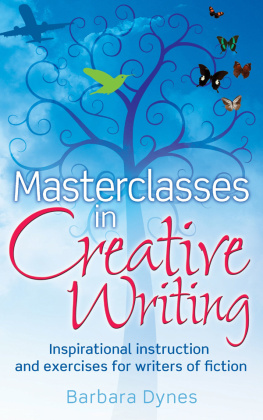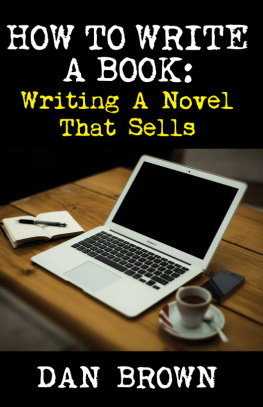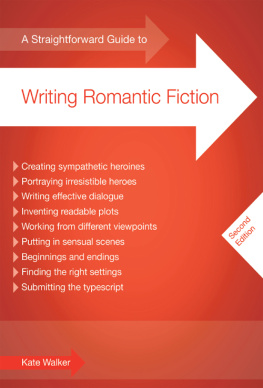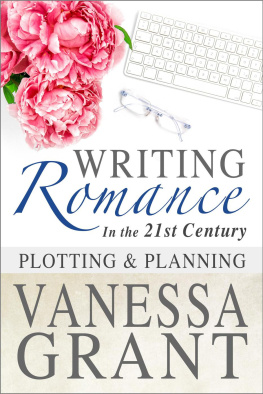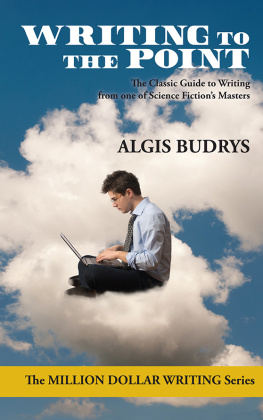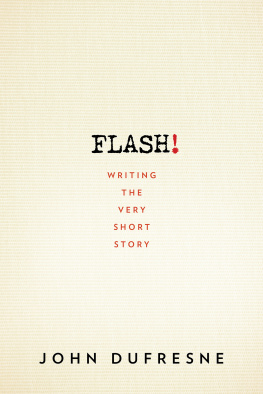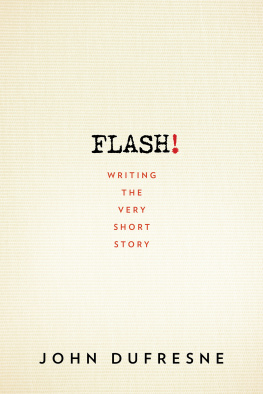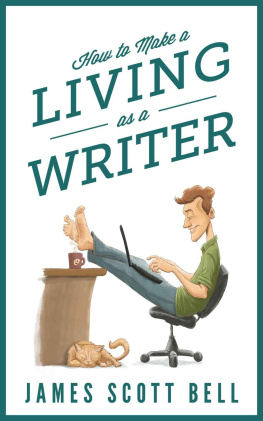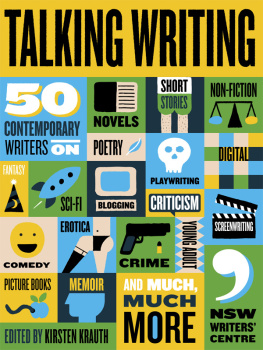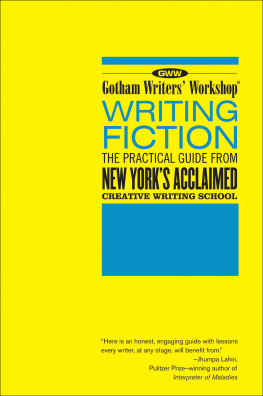LOVE WRITING
SUE MOORCROFT
Published by Accent Press Ltd 2012
ISBN 9781907726057
Copyright Sue Moorcroft 2010
Sue Moorcroft has asserted her right to be identified as the author of this work in accordance with the Copyright, Designs and Patents Act 1988
All rights reserved. No part of this publication may be reproduced, stored in a retrieval system, or transmitted in any form or by any means, electronic, mechanical, photocopying or otherwise without the prior permission of the publisher: Accent Press Ltd, The Old School, Upper High Street, Bedlinog, Mid-Glamorgan CF46 6RY
Cover design by Red Dot Design
For the many contributors to this book.
Acknowledgements
As well as the published writers and industry professionals who kindly answered questions for this book, Im indebted to those people who asked the questions that gave me a clear idea of what readers wanted to know. These questions came from writers groups, the Romantic Novelists Associations New Writers Scheme, a couple of conferences and even over breakfast in the New Cavendish Club. Thank you all for your interest in my book.
Thanks also to all at Accent Press, especially Hazel for being receptive to my ideas for Love Writing when wine and pasta were oiling the creative wheels.
What is romantic fiction? Read these phrases:
Purple passion
Bodice ripper
Pink and fluffy
Now forget them. Theyre nothing to do with current romantic fiction except that journalists like to invoke them from time to time.
Instead, think bright, emotional, involving, intelligent storytelling about love and desire.
Now thats romantic fiction!
Many people think that the terms romance and romantic fiction are interchangeable. But theyre not. Romance is part of romantic fiction but refers to a particularly intense and close focus genre where its not his story; its not her story; its their story. Romantic fiction encompasses everything from romances to chart-topping chick lit and romantic comedies, through gritty sagas, sweeping historicals and smouldering erotica, to liver-twisting affairs with vampires and shapeshifters. If theres a romantic relationship at the core of the story its romantic fiction.
Good romantic novels provide long hours of escape for roughly the cost of a single cinema ticket, transporting us through the hard and hard up times and never jeopardising any existing relationships. Reading romantic fiction grips you by the heart.
Writing it is like falling in love.
You cant concentrate on anything but what colour his eyes are, how she wears her hair, his naughty smile, how shell react when she finds out about his ex, how hell behave when the chips are down.
You shove your kids socks in the oven and the chicken in the washing machine while you mentally arrange the births and marriages in your saga, think up a funny incident that has the potential to descend into disaster for your romantic comedy or wonder when youll have time to research parlour manners in the nineteenth century for your historical romance. Increasingly a student of human nature, youll goggle at your friends relationships dissolving and reforming and slyly note the best bits on napkins at dinner parties.
Youll realise that romantic fiction is preoccupied for longer with obstacles and misunderstandings than it is with resolution and if you let your central female character (heroine) have your central male character (hero) too soon it will be a really boring or short story!
Book deals in the news will catch your interest; youll dream of earning enough to leave your day job and see yourself affording a new computer and a big leather chair, having a private phone line so that your publisher and agent can always call you. (Although you might one day discover that time away from ringing phones becomes your burning goal!)
Because love sells and sex sells there are plenty of writers who earn their living writing about love: novels, short stories and serials for magazines, anthologies and websites. These are writers who have learnt their craft, studied the market and the publishing world, and who have learnt to persist.
And who, normally, have learnt to work hard.
When youre writing about romantic love, sexual love frequently follows. Erotic fiction is an expanding area of publishing and where the boundary lies between hot romantic fiction and erotic fiction is largely a matter of opinion so, for both those reasons, and because lots of people like to read it and to write it, erotic fiction will have some pages of its own.
More on genre, later, because to know what genre or sub-genre your work falls into is imperative to editors, agents and booksellers, so its imperative to you.
Youll need to know where in a bookshop your novel will be found and which country that bookshop is in. Your work might be published in English throughout the English-speaking world and in translation all around the rest of the world, but, generally, it will be published from one place. Each place (market) has its own range of popular genres and itll help you to identify them early on. You might think its lunacy for someone to demand, UK or US? before youve even opened a new file entitled My Romantic Novel on your laptop but it can save you a lot of time and a gigantic amount of disappointment to know.
Youll need to get an idea of who the readers are in a particular market and what it is they want to read. Its true that satisfying an editor comes before satisfying a reader but you dont stand much chance of doing the former if you havent got to grips with the latter.
Once youve learnt what your readers want, you need to give it to them, relentlessly, so that they stick with you for every word of every page. Theres no worse indictment of a book than being put down half-read.
A good way to learn what the reader wants is to read the type of book youre going to write. Not so that you can steal ideas, characters or plots but so you can absorb and understand how that kind of book works, so that youll never submit a book that has an unhappy ending to a romance line sometimes called a series: romances that are similar in length, outlook, sensuality levels etc, - or singe the sensibilities of a sweet romance editor by sending red-hot action.
Keep reading. Read this years books. There are fashions in everything and publishing is no exception.
There are few things so discouraging as having your book rejected not because you cant write but because you wrote the wrong book.
Try this:
Visit a bookshop and search out the books like yours. Are they in the A-Z shelves? Or on shelves containing named categories: romance, womens fiction, historical, saga, romantic comedy, chick lit? Does the publisher have its own section? Is your book likely to earn a prominent position in the shop? Are there banners and offers and other promotions?
Consider how your book might be placed and whether youll be satisfied with the result.
You may not change anything but its as well to be realistic from the start.
Now go and do it in a few more bookshops
Its not true to say that the only romance is a heterosexual romance but I will refer only to a hero and a heroine. Its going to drive us all demented if I keep switching to a hero and a hero or a heroine and a heroine.
I realise that its more precise to use terms like central female character and central male character or female protagonist and male protagonist but none of those terms are fun, sexy or romantic. When your central female character is lusting after your central male character Its a bit clunky.
So, lets look at our hero and heroine.
They are the most important characters in your book. There may be more than one hero and more than one heroine. A romantic comedy or chick lit might be woven around two or even three couples and saga writers have several from each generation. These crucial characters will vary, subtly and not so subtly, from one sub-genre to another. But theyll have the fundamentals in common.


